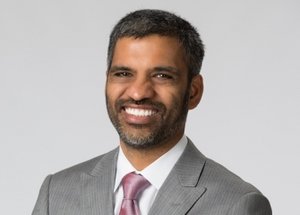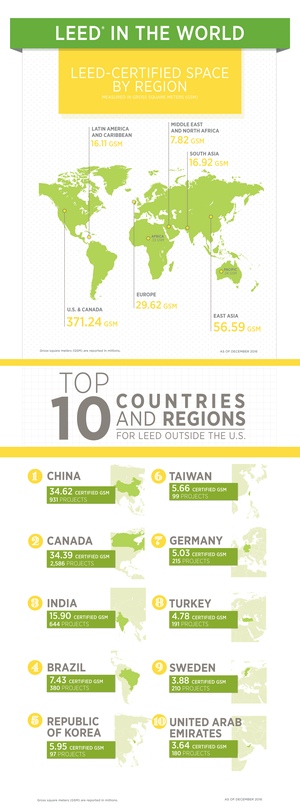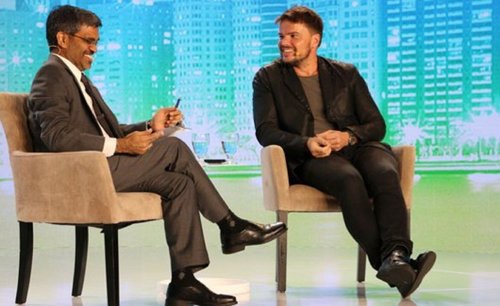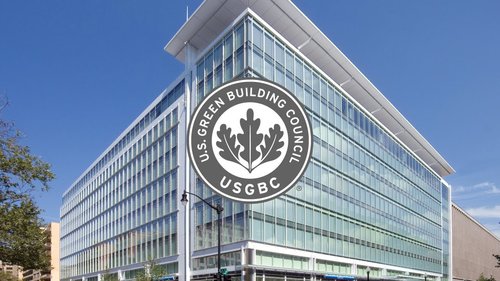
by PAUL BONINGTON, Special to BuiltWorlds | December 19, 2016
In November, Mahesh Ramanujam took the helm as new president and CEO of the US Green Building Council (USGBC), succeeding visionary founder Rick Fedrizzi, who served atop the influential nonprofit for more than 23 years. It was a smooth transition, but one that also signals a strategic shift for the 13,000-member group.
Promoted from within, Mahesh joined USGBC in 2009 as senior vice president of technology, and was elevated to COO in 2011. His deep experience prior to USGBC in large-scale IT systems and enterprise business consulting at IBM, Lenovo, and other big tech firms make him unique among AEC association heads today. And it’s already having a profound impact on the way USGBC is growing and transforming the marketplace. Indeed, when Mahesh talks about USGBC’s role models, he references Apple, Facebook, Google and others — iconic tech giants that have famously disrupted and revolutionized their own major markets.
_________________________________________________________________
I recently met with Mahesh at USGBC’s Washington, DC, headquarters, where he shared with me his insights on leadership, digital transformation, and what lies ahead for the global green movement. Here are some highlights from that discussion:
PB: Mahesh, great to be with you. It’s been quite a journey for you, from big tech and big business to now leading a very big, global association. Tell us a bit about that journey?
MR: Yes, of course. I earned a degree in computer science, and when I came to the US from India, my goal was to engage in large-scale enterprise systems. At that time, the trend was all about IT transformation. However, about two decades ago, a critical shift occurred from IT to business. Technology was no longer the competitive differentiator; it was now all about business strategy enabled by technology. I joined USGBC to help them adapt to this shift by developing the business strategy and technology platform behind LEED Online. What I discovered early on was the incredible “pull” of the sustainability movement, an inbound wave of people and industry professionals looking to participate, learn, and get involved at all levels. This was very different from the commercial world, where you had to “push,” or sell, to transact. This enormous demand from the market to engage with the USGBC needed to be captured, supported, served, and sustained to fulfill the mission. And that required building strong business practices and technology infrastructure.
My journey as a leader, when I became COO here, was to show how driving the mission of the USGBC forward required a coordinated, integrated trajectory of business and digital innovation. We now refer to ourselves as “the Apple of the sustainability movement” — changing, adapting, and disrupting — to continually deliver best-of-class standards and products as the undisputed global brand and market leader. We’ve become a darn good business, while never losing sight of the fact that the mission and movement is the number one priority.
- Below, USGBC’s new LEED On video series debuts with a focus on India:
PB: What was that transition from the business world to a nonprofit like for you personally?
MR: As a business person operating in the association world, it took some time to establish myself. Initially, I was an outsider here, and it was very interesting for me to watch people interact with me differently. I had to continually remind myself (that) I should not pull back from my thinking because the outsider perspective is precisely the value I’m bringing to the table. So I stayed the course. I want to challenge people to think differently. If I’m perceived to be the rebel in the room, that’s okay, because that means I’m doing my job. In the tech world, being a rebel is just part of the job description.
PB: How has your change-management style, first as COO and now as CEO, reshaped the USGBC culture in the way it innovates, prioritizes, develops, and launches new products and services?
MR: One of the most important cultural changes under way is how we go to market. All nonprofits have a lot of great ideas, but not all ideas are scalable. This is a very important lesson we are teaching our people. We’re passionate about the mission, yes, but business competencies do matter. I’ve established a footprint called “managing for failure.” When you look at all the disruptive companies in the world — be it Apple, Amazon, Uber, Tesla, Google, Facebook, etc. — they have an iterative leadership structure of being bold, simple, and taking chances for the future.
That does not mean being reckless, but being able to iterate on ideas quickly, to “fail fast.” You learn from it, and get up and run again. And ultimately you deliver better products in less time with less capital at risk. From a business-case standpoint, there has also been change. The traditional association approach has been that projects must be fully funded before they get started, often from external grants that take time and resources to secure. They would take months to get to market with uncertain outcomes. Now I say, “I’ll give you seed money.” And for every idea presented, I say “yes” simply because I want people to move from the mindset of “we can’t do it now.” to one of “we’ll get started.” If, after a short time, the idea is not aligning with the assumptions of the plan, (then) we assess our failure. No penalties for trying.
“For every idea presented, I say ‘Yes,’ simply because I want people to move from the mindset of ‘we can’t do it now.’ to one of
’we’ll get started.’”
PB: This sounds like elements of “Enterprise Agile” are being adopted at USGBC? Is that the case?
MR: Yes, it’s a scrum. Everything is done in two-week sprints, sometimes four weeks. If a team comes to me and says it will take 18 months, I say two weeks. If they come back after two weeks and say it will be another three months, I say two weeks. It’s a mindset: Fail fast. This is not just for technology. It’s across the board, even in marketing. We take the first-level cut and run with it. If each sprint continues to validate the plan, then we iterate and go on.
PB: In accepting your new role, one of the pledges you made to the marketplace was to “own the vision.” Can you expand on what that means?

MR: I came from the IBM school of management, and the famous line by CEO Lou Gerstner when he began IBM’s transformation [in the early 1990s] was “this organization needs no more strategy, we need execution.” My view is similar. The USGBC vision — which is a world where buildings and communities will regenerate the resources required to sustain the health and vitality of all life on earth — is bold, well established, and has enormous global implications. And as far as we have come today, there is of course much, much more that needs to be accomplished. Now we need to get to work with the leaders in the markets to push the vision forward, to make things happen. For example, each day, two million square feet of building space is certified LEED, a metric that has been consistent over the past five years. That’s an impressive data point. But I ask, “Why has that not grown each year? Why not twice as much more, or 10 times more?” So, when you ask what it means to own the vision, I want to grow the scale of execution. And that’s not just certification. That’s scale in everything we do.
PB: You also pledged that you would provide resources to the community. Are you planning new initiatives beyond what is already being offered by USGBC to its members?
MR: Our brand is powerful. Our leaders and members have been very generous in investing in us. We have a strong reserve. We run like a business. We generate revenue. I don’t want our communities, the heartbeat and the soul of the movement, to focus their time and energy building capabilities locally that distract them from the work of executing the mission. Our most precious commodity is time. By providing centralized access to capital, knowledge, and capabilities, we free up time. I want our communities to take advantage and leverage our resources from a centralized service point of view: our marketing platforms, our databases, our tech infrastructure, our alliances, our relationships, and more. We want to package these for them, provide a kit to enable community leaders to do the work without having to reinvent the wheel and manage the wheel.
It’s a shift in thinking for many in a decentralized association structure to leverage the good work done by others. But we are making progress. As a leader, I’m responsible for creating the templates, packaging the products and services, and making it easy for the marketplace to consume them. Our goal is to deliver products consistently, enhance the customer experience, and increase mission execution velocity.
PB: Is your digital transformation strategy enabling this notion of making your products and services easier to consume, and increasing velocity?
MR: Yes, and this is a very exciting change. In the old model, whenever we wanted to make a change, we’d have to build consensus and an adoption schedule community by community, person by person. Now, through digital transformation, we’re creating what is essentially a global operating system. When we make a change to one of our standards or programs, it will instantly be “pushed” distributed worldwide so everyone can be upgraded overnight — much like the way Apple has the capability to upgrade your iPhone OS today. Through this smart digital deployment process, our communities will own the commitment to local action and not have to worry about the infrastructure. My goal is to transform the USGBC into a 100 percent digital organization within the next five years.

PB: In the wake of a wildly contentious national election, many are wondering now how the green building movement will fare in 2017 and beyond. But how much does regulatory policy really affect USGBC? Have the benefits of building green already passed the tipping point? To where it’s now just accepted as a best business practice regardless of stated public policy?
MR: LEED certification has never been dependent on regulation, although we have been supported in the US and many places around the world as being the de facto standard. So, I would say regulation or deregulation technically doesn’t matter. Today, 88 of the Fortune 100 have mandated LEED to be their standard. That level of corporate acceptance and penetration is a clear indication of market validation. Businesses want a consistent methodology and standard applied to their real estate assets globally.
We have grown over the years into a larger market that has transformed itself from one that sees sustainability as an interesting thing to do, to one that sees sustainability as a core business competency — like sales, marketing, technology, finance, and other services that you need to have within your enterprise. Employees expect it, customers expect it, vendors expect it, and it’s becoming an integral nondiscretionary line item because the benefits are increasingly clear. We’re past the tipping point with one caveat: Some customers don’t quite know that yet. More self-reflective work needs to be done so [that] they can better measure their ROI and the progress they’ve made.
PB: You’ve collected a great deal of data on the sustainable built environment. How is this being leveraged to help the industry raise the bar on performance, measure ROI and other success metrics?
MR: Data, of course, is the new natural resource and we have collected and continue to collect a tremendous amount of data. To unlock its value for the market, we just recently took the bold step of creating a new company, Arc Skoru, under the GBCI [Green Building Certification Institute] umbrella. Arc Skoru will manage and grow our digital, analytics, data, and mobility businesses and will later develop and include artificial intelligence and mission-learning capabilities. As part of our digital transformation, we have encapsulated these areas in the new organization framework with the clear intent of building core competencies that will leverage both big data and small data for deeper economic analysis, scoring, and benchmarks — while generating additional capital to fuel our mission and growth.
PB: What advice would you give to the next generation of architects, engineers, contractors, and real estate professionals coming into the industry who want to make a difference about the way we build in terms of environmental impact and sustainability?
MR: What we have observed is that with the current generation, there is a lot of past, both good and bad, and some of that history can hold us back. What I’d say to our younger generation and emerging professionals is that you have a clean slate now. Just get up there and swing the bat. What are you waiting for? Let’s see what comes. The foundation we are now putting in place will give the next generation the technology, the platforms, and the movement upon which to build — and the rest of the world is waiting to support them. So, I’d say take a chance. Show us how you’d reconfigure this, and question everything we’re doing — because we know we’re trying but not doing enough.
PB: Mahesh, thank you. I appreciate you speaking with me today to share your vision and some of the dynamic and transformational changes taking shape at the USGBC under your leadership. Best of luck to you in your new role and to the USGBC in its ongoing global mission.
MR: Always a pleasure, thank you.
__________________________________________________________________________________________________________

Former publisher of both ENR and Architectural Record, Bonington is now a BuiltWorlds contributor as well as managing director at Digital Prism Advisors, a New York City-based digital transformation consultancy. Contact him via email at pbonington@dprism.com.


Discussion
Be the first to leave a comment.
You must be a member of the BuiltWorlds community to join the discussion.